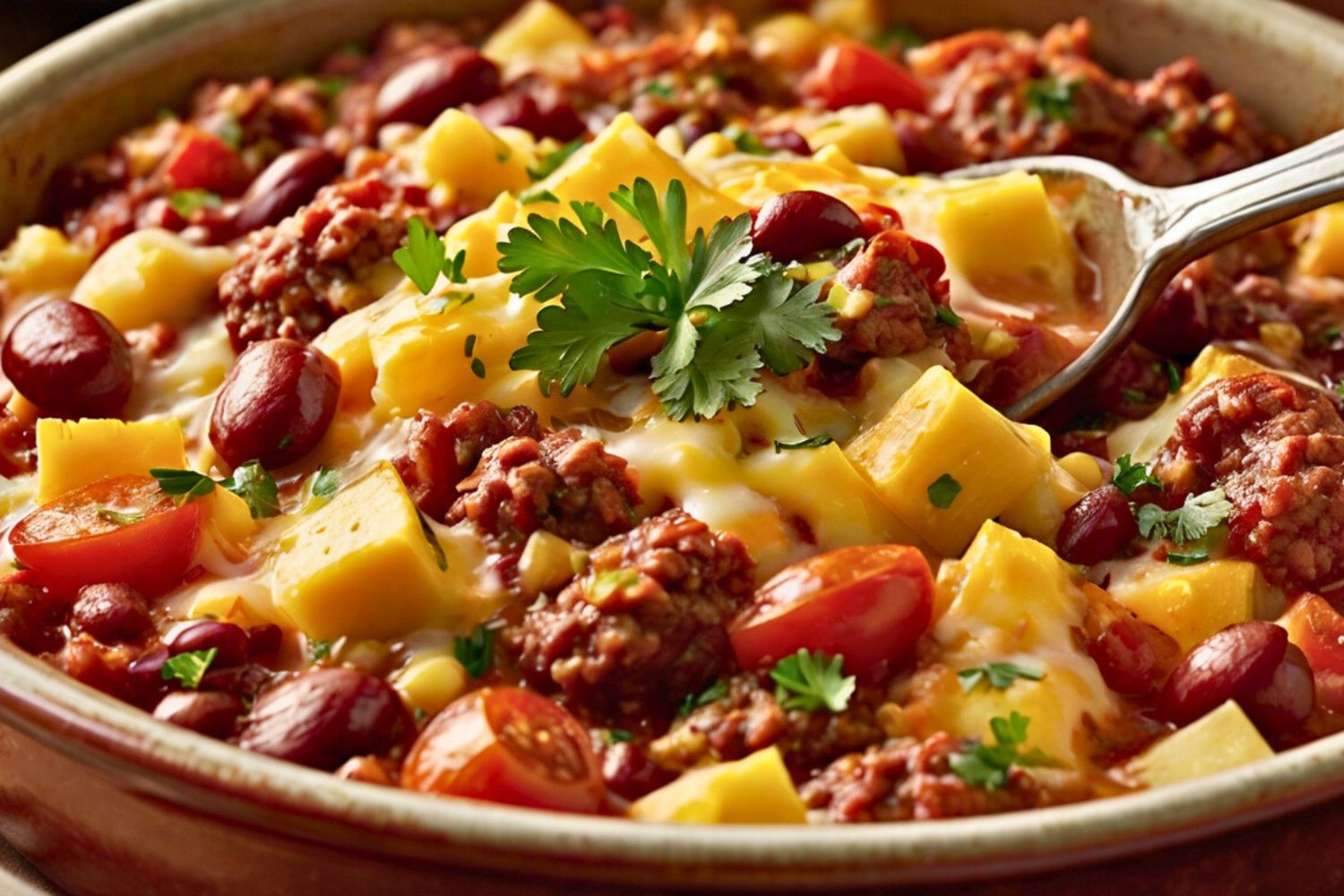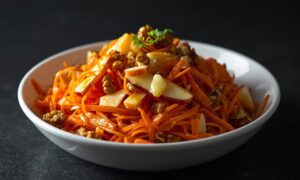You’ve had that day. Long, messy, and dinner is a mystery. Kids want snacks before your coat hits the hook, the wind howls outside, and your energy? Barely enough to reheat leftovers. You’re craving something warm, hearty, and nostalgic, something like a big, bubbling bowl of Crockpot Cowboy Casserole, the kind of dish that fills the house with comfort and smells like home.
That was me last winter. It was a Thursday, cold and dark, and I’d forgotten to defrost anything. Not a cookbook fix. Just me, a craving, and a half-stocked pantry. I browned some beef with onions, sliced up a few potatoes, added corn, beans, a dollop of sour cream, and poured in a little tomato sauce. The slow cooker did its thing, and before long, that garlicky, savory aroma started filling the kitchen.
By dinner, it was magic. The Crockpot Cowboy Casserole came together with creamy sauce, fork-tender potatoes, and bold flavor in every bite. It had that campfire-cooked charm, rustic, layered, and unbelievably satisfying.
If that sounds like your kind of evening, stick around. This post walks you through each step, from ingredient swaps to serving tips, so you can bring this Crockpot Cowboy Casserole to life with whatever’s in your pantry. Trust me, once you taste it, you’ll be making it on repeat.
Why This Crockpot Cowboy Casserole Will Change Your Dinner Game
Cowboy cooking was born from necessity on open ranges. Simple ingredients had to stretch far and satisfy hungry folks doing hard work. This modern version captures that spirit but adapts perfectly to busy lives.
Magic happens in layers. We build flavors from the ground up, starting with proper beef searing, then let everything meld over hours of gentle heat. The result? Fork-tender meat and flavor-soaked vegetables.
This Crockpot Cowboy Casserole recipe combines traditional cowboy ingredients with smart cooking techniques. You get rustic campfire appeal, refined enough for company.
Ingredients & Smart Swaps
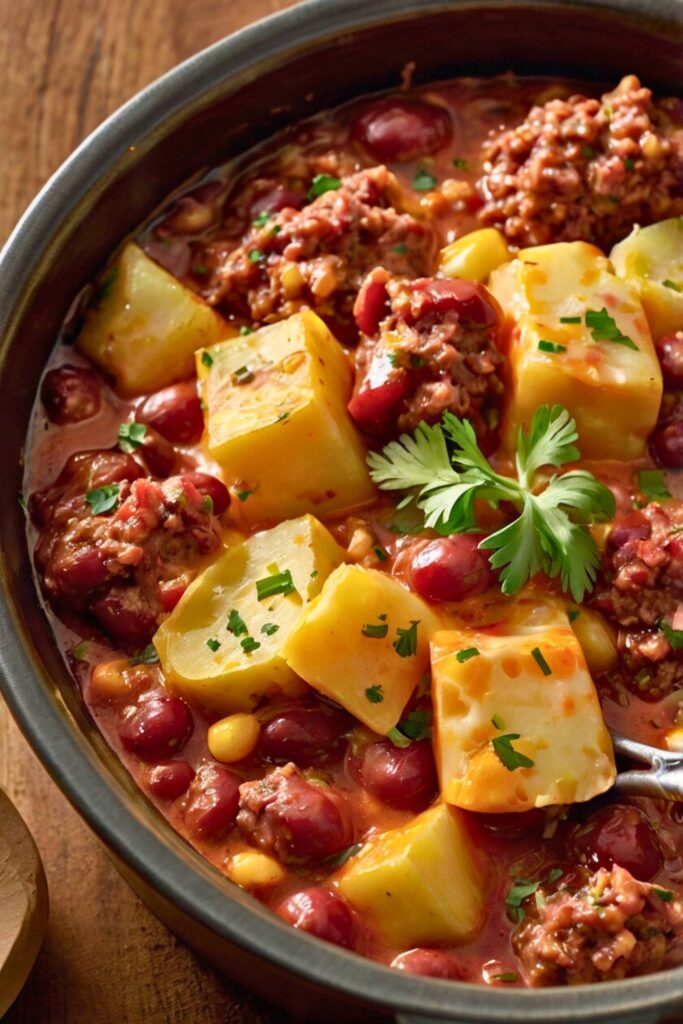
The Foundation Players
2 lbs beef chuck roast, cut into 2-inch chunks
- Chuck roast becomes your best friend here. It contains enough fat to stay juicy and enough connective tissue to break down into silky goodness. Don’t choose lean cuts – you’ll regret it.
2 tablespoons vegetable oil
- For searing. Canola works great too, but skip the olive oil for this step – it doesn’t like high heat.
1 large yellow onion, chopped
- Yellow onions work perfectly because they turn sweet and jammy. White onions work fine, but avoid red – they get funky in long braises.
3 cloves garlic, minced
- Fresh is best, but if you’re using jarred, use about 1 tablespoon.
3 tablespoons tomato paste
- This little powerhouse adds incredible depth. Don’t skip it.
1/4 cup all-purpose flour
- For thickening. Gluten-free folks, try rice flour or cornstarch mixed with cold water.
The Flavor Builders
2 cups beef broth
- Low-sodium broth gives you salt control. Bone broth elevates everything if you have it.
1 bottle (12 oz) dark beer
- Porter or stout works beautifully. Non-drinkers can substitute more beef broth plus apple cider vinegar splash.
2 tablespoons Worcestershire sauce
- That umami punch that makes everything taste more “beefy.”
2 teaspoons smoked paprika
- Regular paprika works, but smoked gives you that campfire flavor without the actual fire.
1 teaspoon dried thyme
- Fresh is lovely (use 1 tablespoon), but dried is more practical for most of us.
2 bay leaves
- Remove these before serving – nobody wants to bite into a bay leaf.
The Hearty Additions to Your Cowboy Casserole Recipe
1 lb baby potatoes, halved
- If you can’t find baby potatoes, cube up some russets or Yukon golds.
3 large carrots, cut into 1-inch pieces
- Baby carrots work too, but they can get mushy faster.
1 cup frozen corn
- Adds sweetness and that classic cowboy touch. Fresh corn off the cob is amazing when it’s in season.
1 cup frozen peas
- We add these in the last 30 minutes to keep them from turning to mush.
Salt and black pepper to taste
Smart Swaps for Every Kitchen
Got dietary restrictions? No problem. This recipe is surprisingly adaptable.
For gluten-free: Use rice flour instead of wheat flour, or skip it entirely and thicken with a cornstarch slurry at the end.
Can’t do beef? Pork shoulder works wonderfully, or try large chunks of portobello mushrooms for a vegetarian version that’s still incredibly satisfying.
No beer on hand? Replace with additional beef broth and add a tablespoon of apple cider vinegar for that slight tang.
Living somewhere without smoked paprika? Regular paprika plus a tiny pinch of chipotle powder gets you close.
Each ingredient brings something important to the party. Beef provides richness, vegetables add sweetness and texture, aromatics build the flavor foundation that makes this dish sing.
Step-by-Step Magic for the Perfect Cowboy Casserole
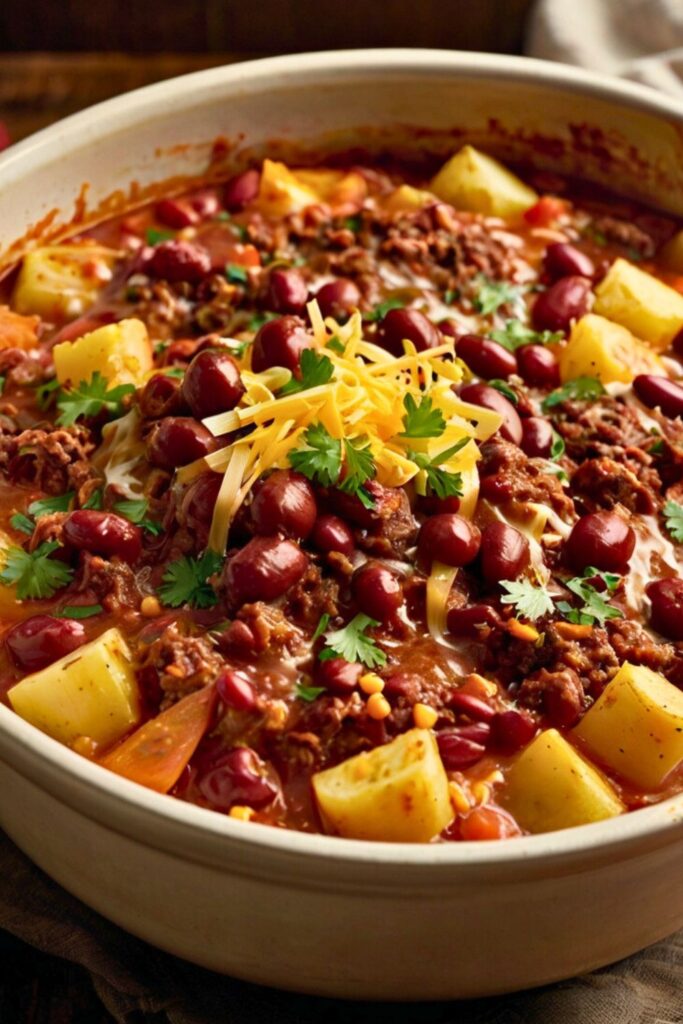
Getting Started Right
Pat your beef chunks completely dry with paper towels. This might seem fussy, but wet meat won’t brown properly – it steams and turns gray. Season those chunks generously with salt and pepper fifteen minutes before cooking. This gives seasoning time to penetrate the surface.
Heat oil in a large skillet over medium-high heat. You want it hot enough that water drops sizzle immediately. Work in batches – don’t crowd the pan! Sear beef chunks on all sides until deep golden brown. Plan on 3-4 minutes per side.
People mess up here – they move meat too soon. Let it sit and develop gorgeous crust. If it sticks, it’s not ready to flip. That caramelization creates pure flavor gold.
Transfer seared beef to your slow cooker. Don’t clean that skillet – those brown bits equal treasure.
Building the Flavor Base
In the same skillet, add your chopped onion. The residual oil should be enough, but add a splash more if needed. Cook until they start to soften and turn golden, about 5 minutes.
Add the garlic and cook for another 30 seconds until it’s fragrant. Now comes the secret weapon – that tomato paste. Add it to the pan and cook for about 2 minutes, stirring constantly. This step caramelizes the tomato paste and deepens its flavor dramatically.
Sprinkle the flour over everything and stir constantly for about a minute. This cooks out the raw flour taste and helps prevent lumps later.
The Deglaze Dance
Pour in about half a cup of your beef broth and scrape up all those beautiful brown bits from the bottom of the pan. This is called deglazing, and it’s where magic happens. All that stuck-on goodness dissolves into your liquid, creating incredible depth.
Add the beer (if using), Worcestershire sauce, smoked paprika, thyme, and bay leaves. Bring everything to a simmer and let it bubble for a couple minutes to cook off some of the alcohol.
Pour this entire mixture over your beef in the slow cooker. Add the remaining broth, potatoes, and carrots. Give everything a gentle stir.
The Long, Slow Simmer
Cover and cook on low for 6-8 hours or high for 3-4 hours. The beef should be fork-tender when it’s done – meaning you can easily shred it with just a fork.
About 30 minutes before serving, stir in the frozen corn and peas. This timing keeps them from overcooking while still heating them through completely.
Taste and adjust seasoning. Remove those bay leaves before serving – trust me, you don’t want anyone biting into one of those.
Pro Tips for Perfect Results
If your casserole seems too thin at the end, mix 2 tablespoons of cornstarch with 3 tablespoons of cold water. Stir this slurry into the pot and let it cook for another 15-20 minutes on high.
Want deeper flavor? Add a square of dark chocolate or a tablespoon of coffee during the last hour. Sounds weird, but it adds incredible richness without being identifiable.
Feeling adventurous? Throw in some diced jalapeños with the onions, or add a chipotle pepper in adobo sauce for smoky heat.
The Science Behind the Sizzle
There’s real chemistry happening in your slow cooker that transforms tough chuck roast into melt-in-your-mouth perfection. Chuck roast contains tons of collagen – tough connective tissue that makes cheap cuts chewy when you cook them quickly. Give it time and gentle heat, and collagen slowly breaks down into gelatin, creating rich, silky texture that makes this dish satisfying.
Searing isn’t just for show. When you caramelize meat’s surface, you create hundreds of new flavor compounds through the Maillard reaction. These compounds add depth and complexity that you can’t get by throwing raw meat into slow cookers.
Alcohol acts as a solvent, helping extract flavors from ingredients that water alone can’t touch. As it cooks, alcohol evaporates, leaving concentrated flavors that make everything taste more intensely like itself.
Slow, moist cooking breaks down tough fibers without drying meat. Unlike high-heat methods that turn budget cuts into shoe leather, slow cooking gives collagen time to transform while keeping muscle fibers tender and juicy.
That tomato paste trick works magic. When you cook it in fat, you make fat-soluble flavor compounds available to your palate. Raw tomato paste tastes sharp and acidic, but caramelized paste becomes sweet, complex, and incredibly savory.
Making It Beautiful & Delicious
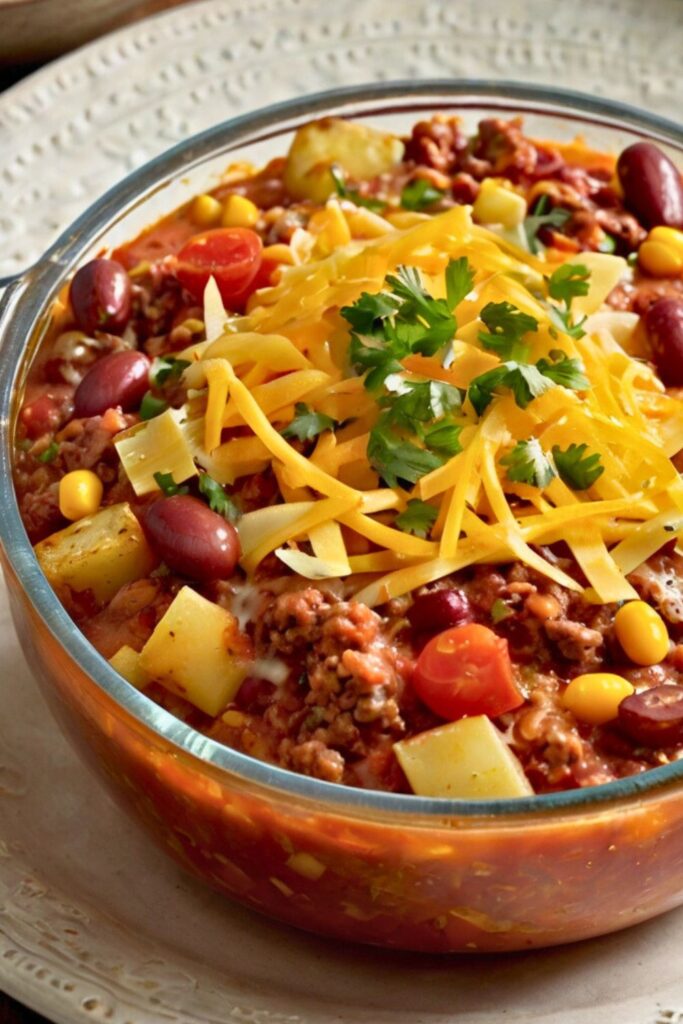
Presentation That Wows
This rustic dish shines without fancy plating. Serve in wide bowls to highlight the hearty meat and veggies, topped with parsley or chives for color. Feeding a crowd? Go family-style with a big bowl and ladle, it suits the cozy vibe. For photos, use natural light to capture the rich, warm tones beautifully.
Perfect Pairings
This hearty casserole pairs beautifully with simple sides that don’t compete for attention. Crusty bread for sopping up that incredible gravy is non-negotiable. A simple green salad with a bright vinaigrette cuts through the richness perfectly.
For wine lovers, this dish begs for something bold. A Cabernet Sauvignon or Malbec can stand up to those rich flavors. Beer drinkers should try a porter or stout – echoing the beer in the recipe.
If you want to make it a complete meal, serve over mashed potatoes, egg noodles, or even polenta. Rice works too, especially if you want to stretch the dish to feed more people.
Wrapping It Up – Slow Cooker Cowboy Casserole Recap
The beauty of Crockpot Cowboy Casserole is its simplicity and flexibility. Each time you make it, you’ll learn how to tweak the flavors, add more heat, swap veggies, or adjust to your taste.
It’s more than a meal, it’s comfort on a cold day and a lifesaver on busy nights. The slow cooker does the work, and you’re left with something that tastes homemade and heartfelt.
Cooking is about bringing people together. This dish fills your home with rich aromas and creates moments worth remembering.
Start with the basics, then make it your own. Taste, adjust, and enjoy the process—cowboy cooking is all about heart.
Frequently Asked Questions
Can I make this recipe ahead of time?
This Crockpot Cowboy Casserole tastes even better the next day. Prep it the night before, brown the meat, sauté the aromatics, and store everything in the slow cooker insert. In the morning, just set it and go. The flavors deepen overnight, and it also freezes well for up to three months. Thaw in the fridge and reheat gently
What if my casserole turns out too watery?
No worries, it’s fixable! Mix 2 tbsp cornstarch with 3 tbsp cold water, stir into the casserole, and cook on high for 15-20 minutes. You can also remove the lid for the last hour to reduce moisture, or quickly reduce some liquid on the stove and stir it back in. Just be patient, slow cookers vary in moisture retention.
Can I use a different cut of beef?
Chuck roast is ideal for its fat and connective tissue, but short ribs and brisket are great too. Avoid lean cuts like sirloin, they dry out. For a splurge, beef cheeks become melt-in-your-mouth tender.
How do I know when it’s done?
The beef should shred easily with a fork, if not, it needs more time. Don’t worry about overcooking; it’s a forgiving dish. Veggies should be tender, not mushy. If they’re softening too fast, add them later in the cook
What’s the best way to store and reheat leftovers?
Store leftovers in airtight containers for up to 4 days. Reheat gently, microwave at 50% power or warm on the stove over low heat. Add a splash of broth if it’s too thick. The flavors improve over time, and the recipe doubles easily for meal prep or feeding a crowd.

Swiftly Captions by Tina Smith — Quick, flavorful food recipes made simple, bringing fresh inspiration to your kitchen every day
